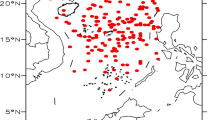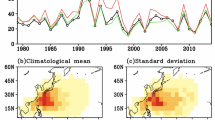Abstract
Based on outgoing longwave radiation (OLR), an index for clustering tropical cyclogenesis (CTC) over the western North Pacific (WNP) was defined. Around 76 % of total CTC events were generated during the active phase of the CTC index, and 38 % of the total active phase was concurrent with CTC events. For its continuous property, the CTC index was used as the representative predictand for extended-range forecasting the temporal distribution of CTC events.
The predictability sources for CTC events were detected via correlation analyses of the previous 35–5-day lead atmospheric fields against the CTC index. The results showed that the geopotential height at different levels and the 200 hPa zonal wind over the global tropics possessed large predictability sources, whereas the predictability sources of other variables, e.g., OLR, zonal wind, and relatively vorticity at 850 hPa and relatively humility at 700 hPa, were mainly confined to the tropical Indian Ocean and western Pacific Ocean.
Several spatial-temporal projection model (STPM) sets were constructed to carry out the extended-range forecast for the CTC index. By combining the output of STPMs separately conducted for the two dominant modes of intraseasonal variability, e.g., the 10–30 and the 30–80 day mode, useful forecast skill could be achieved for a 30-day lead time. The combined output successfully captured both the 10–30 and 30–80 day mode at least 10 days in advance. With a relatively low rate of false alarm, the STPM achieved hits for 80 % (69 %) of 54 CTC events during 2003–2014 at the 10-day (20-day) lead time, suggesting a practical value of the STPM for real-time forecasting WNP CTC events at an extended range.








Similar content being viewed by others
References
Bretherton CS, Widmann M, Dymnikov VP, Wallace JM, Bladé I (1999) The effective number of spatial degrees of freedom of a time-varying field. J Clim 12:1990–2009
Cao X, Huang P, Chen G, Chen W (2012) Modulation of western North Pacific tropical cyclone genesis by intraseasonal oscillation of the ITCZ: a statistical analysis. Adv Atmos Sci 29(4):744–754
Elsberry RL, Tsai HC, Jordan MS, Vitart F (2014) Extended-range forecasts of Atlantic tropical cyclone events during 2012 using the ECMWF 32-day ensemble predictions. Weather Forecast doi. doi:10.1175/WAF-D-13-00104.1
Frank WM, Roundy PE (2006) The role of tropical waves in tropical cyclogenesis. Mon Wea Rev 134:2397–2417. doi:10.1175/MWR3204.1
Fu B, Li T, Peng M, Weng F (2007) Analysis of tropical cyclogenesis in the western North Pacific for 2000 and 2001. Weather Forecast 22:763–780
Gao JY, Li T (2011) Factors controlling multiple tropical cyclone events in the western North Pacific. Mon Wea Rev 139:885–894. doi:10.1175/2010MWR3340.1
Gao JY, Li T (2012) Interannual variation of multiple tropical cyclone events in the western North Pacific. Adv Atmos Sci 29(6):1279–1291. doi:10.1007/s00376-012-1031-1
Gray WM (1968) Global view of the origin of tropical disturbances and storms. Mon Wea Rev 96:669–700
Gray WM (1979) Hurricanes: their formation, structure, and likely role in the tropical circulation. In: Shaw DB (ed) Meteorology over the tropical oceans. Roy Meteor Soc, London
Hsu PC, Li T (2012) Role of the boundary layer moisture asymmetry in causing the eastward propagation of the Madden–Julian Oscillation. J Clim 25:4914–4931
Hsu PC, Li T, You LJ, Gao JY, Ren HL (2015) A spatial-temporal projection method for 10-30-day forecast of heavy rainfall in Southern China. Clim Dynam 44:1227–1244
Kanamitsu M, Bisuzaki EW, Woollen J, Yang SK, Hnilo JJ, Fiorino M, Potter GL (2002) NCEP–DOE AMIP-II reanalysis (R-2. B Am Meteorol Soc 83:1631–1643
Kim KH, Ho CH, Kim HS, Sui CH, Ki PS (2008) Systematic variation of summertime tropical cyclone activity in the western North Pacific in relation to the Madden–Julian Oscillation. J Clim 21:1171–1191. doi:10.1175/2007JCLI1493.1
Klotzbach PJ, Oliver ECJ (2015) Variations in global tropical cyclone activity and the Madden-Julian Oscillation since the mid-twentieth century. Geophys Res Lett 42. doi:10.1002/2015GL063966
Ko KC, Hsu HH (2009) ISO modulation on the sub-monthly wave pattern and recurving tropical cyclones in the tropical western North Pacific. J Clim 22:582–599. doi:10.1175/2008JCLI2282.1
Lander MA (1996) Specific tropical cyclone track types and unusual tropical cyclone motions associated with a reverse-oriented monsoon trough in the western North Pacific. Weather Forecast 11:170–186
Li WK, Hsu PC, He JH, Zhu ZW, Zhang WJ (2016) Extended-range forecast of spring rainfall in southern China based on the Madden–Julian Oscillation. Meteorog Atmos Phys 128:331–345
Liebmann B, Smith CA (1996) Description of a complete (interpolated) outgoing longwave radiation dataset. B Am Meteorol Soc 77:1275–1277
Liebmann B, Hendon HH, Glick JD (1994) The relationship between tropical cyclones of the western Pacific and Indian Oceans and the Madden-Julian oscillation. J Meteorol Soc Jpn 72:401–412
Maloney ED, Hartmann DL (2000a) Modulation of eastern North Pacific hurricanes by the Madden–Julian oscillation. J Clim 13:1451–1460. doi:10.1175/1520-0442(2000)013<1451:MOENPH>2.0.CO;2
Maloney ED, Hartmann DL (2000b) Modulation of hurricane activity in the Gulf of Mexico by the Madden-Julian oscillation. Science 287:2002
Tsai HC, Elsberry RL (2013) Opportunities and challenges for extended-range predictions of tropical cyclone impacts on hydrological predictions. J Hydrometeorol 506:42–54. doi:10.1016/j.jhydrol.2012.12.025
Van Den Dool HM, Saha S (1990) Frequency dependence in forecast skill. Mon Wea Rev 118:128–137
Vitart F, Prates F, Bonet A, Sahin C (2012) New tropical cyclone products on the web. ECMWF Newsletter No 130:17–23
Wen M, Li T, Zhang R, Qi Y (2010) Structure and origin of the quasi-biweekly oscillation over the tropical Indian Ocean in boreal spring. J Atmos Sci 67:1965–1982
William MF, Roundy PE (2006) The role of tropical waves in tropical cyclogenesis. Mon Wea Rev 134:2397–2417. doi:10.1175/MWR3204.1
Xiang BQ, Lin SJ, Zhao M, Zhang S, Vecchi G, Li T, Jiang X, Harris L, Chen JH (2015) Beyond weather time-scale prediction for Hurricane Sandy and Super Typhoon Haiyan in a global climate model. Mon Wea Rev 143:524–535. doi:10.1175/MWR-D-14-00227.1
Yamaguchi M, Vitart F, Simon T, Linus M, Russell LE, Grant E, Masayuki K, Tetsuo N (2015) Global distribution of the skill of tropical cyclone activity forecasts on short- to medium-range time scales. Wea Forecasting 30:1695–1709
Zhang C (2013) Madden-Julian oscillation: bridging weather and climate. B Am Meteorol Soc 94:1849–1870
Zhu ZW, Li T (2016) The statistical extended-range (10-30-day) forecast of summer rainfall anomalies over the entire China. Clim Dynam DOI. doi:10.1007/s00382-016-3070-2
Zhu ZW, Li T, Hsu PC, He JH (2015) A spatial-temporal projection model for extended-range forecast in the tropics. Clim Dynam 45:1085–1098
Acknowledgments
The authors would like to thank the two anonymous reviewers for their constructive comments. This work was supported by the Natural Science Foundation of Jiangsu Province (BK20140046), the China National 973 project (2015CB453200), the Special Fund for Meteorological Scientific Research of the Public Sector (Grant no. GYHY201306032), the National Natural Science Foundation of China (41575052/41630423), the key project of the Fujian Provincial Department of Science and Technology (2011Y0008), and the PAPD (Priority Academic Program Development) of Jiangsu Higher Education institutions. This paper is SOEST contribution number 9817, IPRC contribution number 1210 and ESMC contribution number 125.
Author information
Authors and Affiliations
Corresponding authors
Rights and permissions
About this article
Cite this article
Zhu, Z., Li, T., Bai, L. et al. Extended-range forecast for the temporal distribution of clustering tropical cyclogenesis over the western North Pacific. Theor Appl Climatol 130, 865–877 (2017). https://doi.org/10.1007/s00704-016-1925-4
Received:
Accepted:
Published:
Issue Date:
DOI: https://doi.org/10.1007/s00704-016-1925-4




